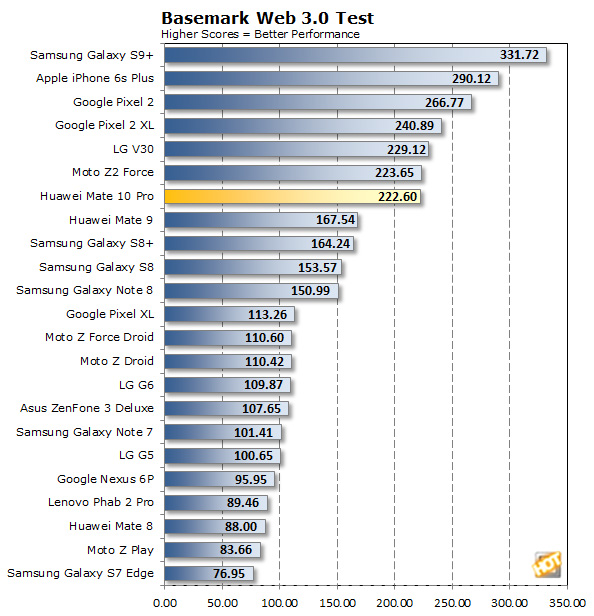Smartphones are increasingly becoming the way many people access the Internet, engage in social networks, and even get business-critical work done. A smartphone needs to have a responsive web browsing system to render complex pages fast, along with a reliable cellular or WiFi connection. We can’t easily, quantitatively measure how well these various radios perform in different phones, as the variables between carriers and access points are too difficult to lock down for reliable test methodology. However, we
can investigate general browser performance between devices.
For our first tests we're using the JetStream benchmark for
Javascript processing, as well as RightWare’s Web Test 3.0, for a comprehensive look at modern web rendering performance, including the latest in
HTML5. Here we're primarily determining how the Mate 10 Pro's core CPU architecture handles this workload, along with the phone's web browser software stack running Chrome on Android 8.0.
 |
|
JetStream and BrowserMark |
| JavaScript and Browser Testing |
|
Huawei's Mate 10 Pro starts things off with a brisk pace, landing around the middle of the pack in Jetstream and at the lower end of the upper quadrant in Browsermark. In the latter test, the Mate 10 Pro posts a score that is significantly higher than its predecessor, the Mate 8. However, it's not able to hang with flagships from other companies, including
Samsung's brand-spanking-new
Galaxy S9+. Even though both are equipped with 6GB of RAM, in the early going it looks like Qualcomm's
Snapdragon 845 SoC has Huawei's HiSilicon Kirin 970 beat.
 |
AnTuTu 7
|
|
Platform Benchmarks |
|
AnTuTu’s latest benchmark (now updated results here with version 7) returns a number of metrics ranked with somewhat nebulous scores, rather than frame rates or time to complete. Scrambling to hit Samsung's embargo lift, we're short on a few competitive devices here. We hope to add to this in the future though we do have some top Android handsets for reference. Regardless, AnTuTu returns four top level performance metric results that we are including below: CPU, RAM, 3D, UX (or User Experience), along with a total score. Since this is an Android benchmark, we don't have Apple products to show in the mix here.

Things look decidedly better in AnTuTu, with the Mate 10 Pro taking a second place finish. We have a smaller sample size since version 7 of this benchmark just recently came into view. However, the Kirin 970 starts to flex its muscle here, allowing the Mate 10 Pro to outperform Google's Pixel 2 XL, Samsung's last generation Galaxy S8+, and LG's V30.
 |
|
Geekbench |
|
Synthetic CPU Testing |
|
In the GeekBench test, we're stressing only CPU cores in a handset (not graphics or GPU architecture), with both single and multi-threaded workloads. The tests are comprised of encryption processing, image compression, HTML5 parsing, physics calculations and other general purpose compute mobile processing workloads.

We see more of the same in Geekbench. The Mate 10 Pro trails only the Galaxy S9+ and Apple's iPhone X with its beastly A11 Bionic processor. Along with the AnTuTu scores, this shows us that the Kirin 970 is a stout piece of silicon, even if it's not able to wrestle the performance crown from the best that Qualcomm and Apple have to offer..
 |
|
Futuremark PCMark For Android |
|
General Purpose Pocket Computing Performance Metrics |
|
Futuremark's PCMark for Android is a new benchmark addition here for us, so again we have fewer results in our database of tested phones to show you. However, this is an excellent suite of tests that we recommend for benchmarking performance of a handset with heavier-duty tasks for things like image manipulation and video editing, as well as lighter-duty workloads like email, and web browsing. When you see the test running live it's clear its scripted application tests are carefully selected and tuned to make use of the platforms involved in a very controlled way.

The Mate 10 Pro puts on another strong showing in PCMark for Android. Where exactly it falls in line depends on which test you sort the scores by. Generally speaking, however, it lands around fourth place next to some other heavyweights and ahead of most previous generation phones. AnTuTu’s latest benchmark returns a number of metrics ranked with nebulous scores, rather than frame rates or time to complete. We tested with the latest version of AnTuTu across all platforms including Android, iOS and even Windows Phone. AnTuTu returns four top level performance metric results that we are including here: CPU, RAM, 3D, UX (or User Experience), along with a total score.













